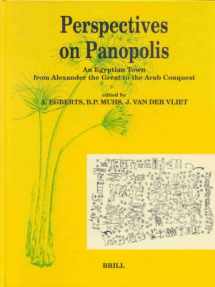
Perspectives on Panopolis: An Egyptian Town from Alexander the Great to the Arab Conquest (Papyrologica Lugduno-Batava)
ISBN-13:
9789004117532
ISBN-10:
9004117539
Author:
A. Egberts, B..P. Muhs, J. Van Der Vliet, Brian Paul Muhs, Joep Van Der Vliet
Publication date:
2002
Publisher:
Brill Academic Pub
Format:
Hardcover
224 pages
FREE US shipping
Book details
ISBN-13:
9789004117532
ISBN-10:
9004117539
Author:
A. Egberts, B..P. Muhs, J. Van Der Vliet, Brian Paul Muhs, Joep Van Der Vliet
Publication date:
2002
Publisher:
Brill Academic Pub
Format:
Hardcover
224 pages
Summary
Perspectives on Panopolis: An Egyptian Town from Alexander the Great to the Arab Conquest (Papyrologica Lugduno-Batava) (ISBN-13: 9789004117532 and ISBN-10: 9004117539), written by authors
A. Egberts, B..P. Muhs, J. Van Der Vliet, Brian Paul Muhs, Joep Van Der Vliet, was published by Brill Academic Pub in 2002.
With an overall rating of 4.5 stars, it's a notable title among other
books. You can easily purchase or rent Perspectives on Panopolis: An Egyptian Town from Alexander the Great to the Arab Conquest (Papyrologica Lugduno-Batava) (Hardcover) from BooksRun,
along with many other new and used
books
and textbooks.
And, if you're looking to sell your copy, our current buyback offer is $0.3.
Description
Panopolis, the modern town of Akhmim in Southern Egypt, was in Graeco-Roman times an important religious and cultural centre. Its gigantic temple was a stronghold of traditional Egyptian religion. In Late Antiquity it became a major centre of Hellenistic literature and learning and, at the same time, of Coptic monasticism. The sources for Graeco-Roman Panopolis are numerous and diverse. They not only include numerous texts of all genres in various scripts and languages, but archaeological artefacts too. This volume brings together seventeen contributions, dealing with epigraphy, both hieroglyphic and Greek, Greek papyri, Demotic funerary texts, Coptic literature and local monastic architecture. Without neglecting the heuristic problems which these various sources pose, they conjure up a vivid picture of a world marked by profound religious and cultural change.


We would LOVE it if you could help us and other readers by reviewing the book
Book review

Congratulations! We have received your book review.
{user}
{createdAt}
by {truncated_author}


